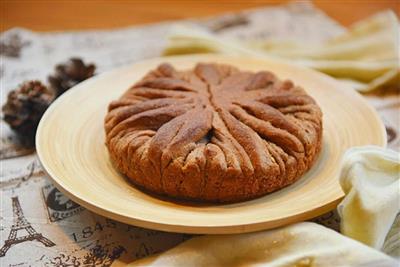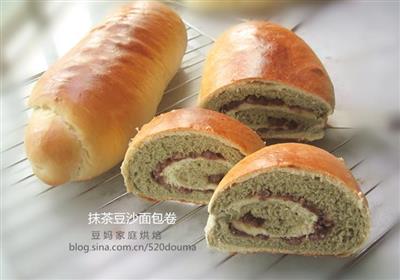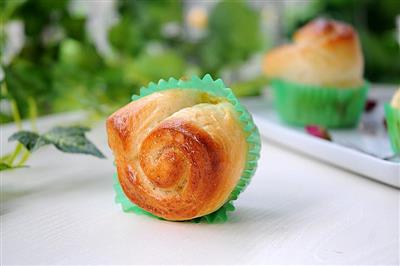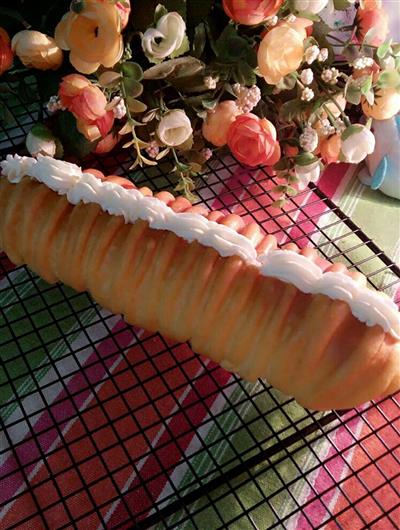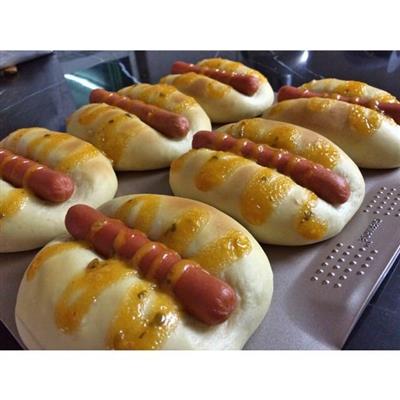Scented gold bread rolls

(The dosage is for reference only, please read the Tips before making it.)The most special thing about this bread is that it is made by folding and unfolding the dough many times to make it delicate, and finally to give the finished product a beautiful silk effect and a clean and delicate outer skin. After testing it by hand, my feeling is that this method of operation can really make the dough very uniform.I think it's like we're making a dumpling, and then we're fermenting it, and then we're squeezing it out, and then we're squeezing out all the bubbles, and then the dumpling is delicate and the skin is clean.However, the operation process is relatively cumbersome.Although the main dough does not need to be kneaded to a complete state as in the past, the subsequent process of folding and unfolding is actually very time-consuming.Also, when folding and unfolding repeatedly, do a good job of moistening the dough, otherwise it will be easy for the dough to dry out.All in all, if you're like me, curious about new things, with a spirit of exploration and experimentation, this method is definitely worth a try.
WHAT YOU NEED
Ingredients
12 grams of egg juiceWhole egg juice (B) 30 gHigh starch flour (A) 100 grams5 grams of milk powder12 grams of milk (A)Clean water (A) 36 gramsHigh starch flour (B) 100 gramsLow starch flour (B) 100 gramsMilk powder (B) 20 gMilk (B) 60 gramsSugar powder (A) 20 grams1 g of salt (A)High sugar yeast (A) 1 gUnsalted butter (A) 10 gSalt (B) 2 gSugar powder (B) 40 gramsHigh sugar resistant yeast (B) 2 gUnsalted butter (B) 25 g
How TO MADE Scented gold bread rolls
Steps 1 to 4

1. Mix the ingredients of sweet dough (A) and use the post-oil method to grind to the full stage, i.e. to pull out a large piece of tough film;
2. The mixed dough is placed in a container, covered with a preservative film, and fermented in a warm place;
3. The dough is fermented to a microscopic recess on the surface (it can also be fermented to twice the size), with many bubbles on the surface;
4. Remove and re-mix after exhausting;
Steps 5 to 8
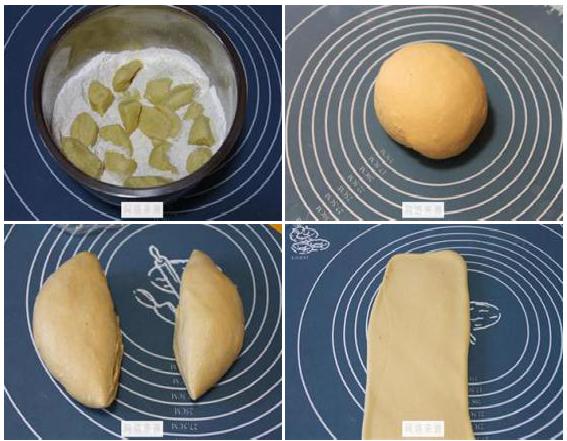
5. Cut the dough into small pieces and mix with the ingredients in the main dough (B);
6. Using post-oil method, knead again into a smooth dough.
7. This time don't knead it all the way, as long as the dough is smooth.
8. Cut the good dough in half;
Steps 9 to 12
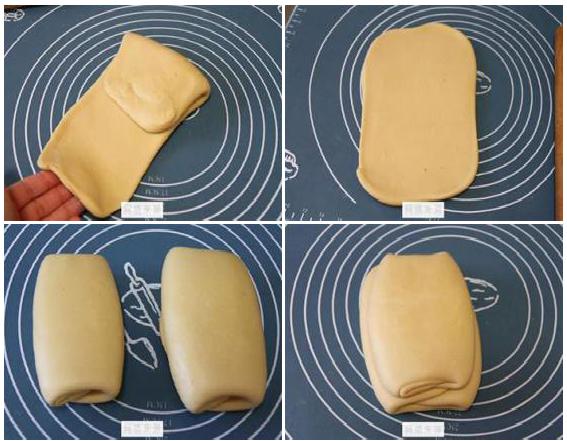
9. Take a flat, open-grown strip;
10. Along the long edge, fold both sides to the middle;
11. Opening the growth square again;
12. Repeated folding - open, about 20 times, until the surface of the dough is shiny and delicate.
Steps 13 to 16
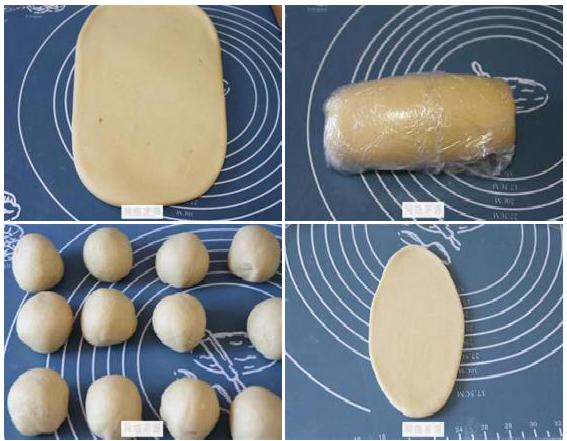
13. The two doughs can be operated alternately.
14. If you feel that the dough is shrinking, you can loosen it properly for a few minutes;
15. Finally, the two doughs are stacked together.
16. Opening the growth square again;
Steps 17 to 20
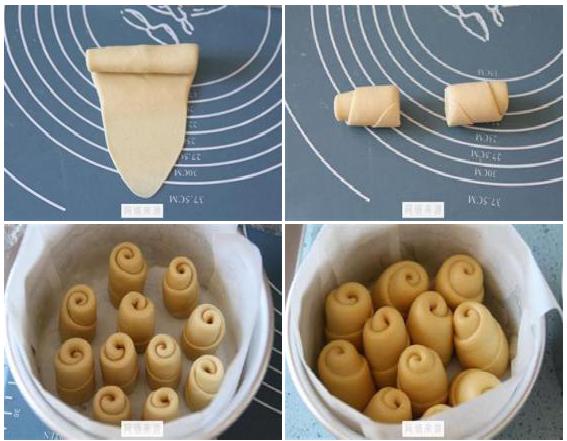
17. Roll the dough, wrap it in a preservative film, and let it simmer for 30 minutes.
18. Divided into small, evenly sized pieces, I divided 12 pieces, each about 45 grams.
19. Roll and cover with a preservative film and relax for 15 minutes;
20. Take a loose, small dough and knead it into a beef tongue.
Steps 21 to 24
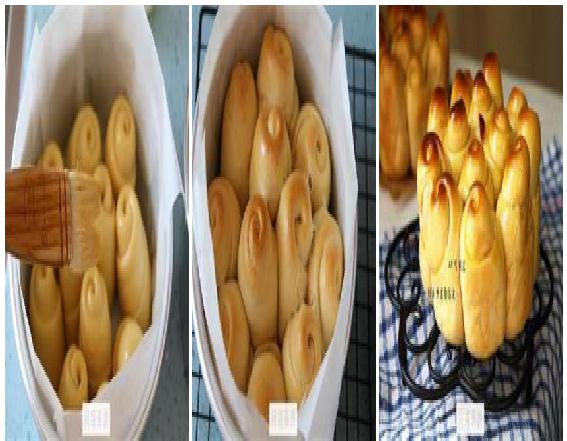
21. Turn it over, press the bottom of one side, roll it up and down;
22. A rolled dough, divided in half from the middle;
23. Cut downwards, place in a pre-covered oil-paper mold, place in a warm, moist place, and do the final fermentation.
24. If the mold is non-sticky, it may not be oil-coated;
25. At a temperature of about 32 degrees, I fermented for 50 minutes.
26. The dough swells to about twice its original volume;
27. Mix the butter and milk in a ratio of 2:1 and brush on the surface of the dough.
28. At the same time, preheat the oven to 170 degrees;
29. After preheating, the mold is placed in the oven, below the middle layer, 160 degrees, and baked for 20 to 25 minutes.
30. Immediately after baking, take out the oven;
31. After removing the mold, the bread is placed in a drying net, cooled to room temperature and not hot, so that it can be sealed and stored.
32.
Handy cooking tips
1. Sweet dough is similar to what we usually call medium dough, but with butter added to the dough.It can be fermented at room temperature or refrigerated.The original is to ferment the sweet dough to twice the size, I sent it to the surface with a slight depression, no problem; 2. when folding and unfolding the dough, be sure to pay attention to the moisture of the dough.In addition, every few operations, it can be slightly loosened for a while, making it easier for the dough to open; 3. the time of second fermentation should be adjusted according to the actual situation.Be careful not to overdo it; 4. the specific baking time and temperature should be adjusted according to the actual situation of each oven.If the color is too fast, you can add tin foil in the middle; 5. the bread should be baked immediately after baking, remove the mold, cool so that it is not hot, you can seal the bag, so as not to be dried by the wind and lose too much water.
REACTION RECIPES
- Cake rolls
- Paper cup cakes with coconut oil
- The classic heavy cheese cake
- Quick handed corn cake
- Fresh orange cake
- The zebra cake
- Naked cake
- Frozen lemon and cheese birthday cake
- Honey and blueberry cake
- Fruit and cheese sandwiches
- Cream and butter cake
- Small cakes with orange juice and sugar
- Black date and sea cucumber cake
- The Black Forest cake
- Hokkaido fried cake
MOST POPULAR RECIPES
- Chocolate open mouth
- Onion biscuits
- Onions and biscuits
- Buttoned cookies
- The practice of milk biscuits
- Tea and cookies
- The classic raw butter cookie
- Sugar cookies
- The biscuit bar
- This is a black sesame cookie.
- Almonds and cookies
- Peanut butter and butter
- Flower bunny cookies
- A basket of cookies
- Margaret's little cookie
RECIPE TAGS:
-
12 grams of egg juiceWhole egg juice (B) 30 gHigh starch flour (A) 100 grams5 grams of milk powder12 grams of milk (A)Clean water (A) 36 gramsHigh starch flour (B) 100 gramsLow starch flour (B) 100 gramsMilk powder (B) 20 gMilk (B) 60 gramsSugar powder (A) 20 grams1 g of salt (A)High sugar yeast (A) 1 gUnsalted butter (A) 10 gSalt (B) 2 gSugar powder (B) 40 gramsHigh sugar resistant yeast (B) 2 gUnsalted butter (B) 25 g

 DESSERTS
DESSERTS  BAKING
BAKING  MAIN DISHES
MAIN DISHES  SNACKS
SNACKS  CHINESE FOOD
CHINESE FOOD  HOME
HOME
